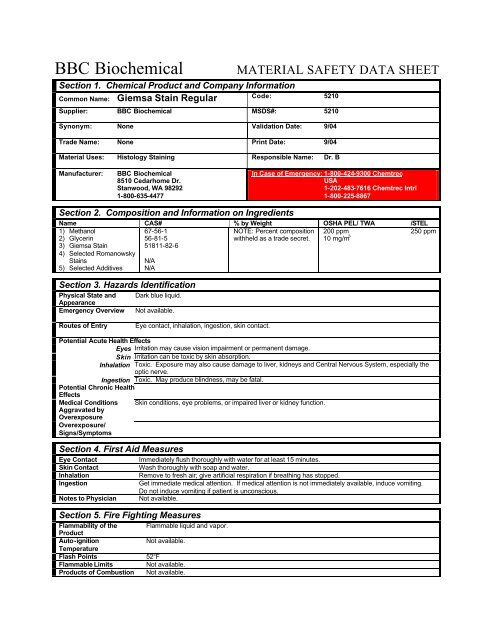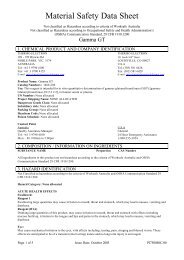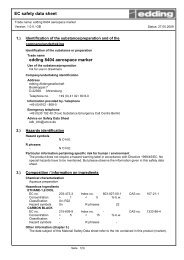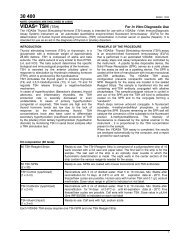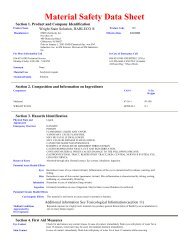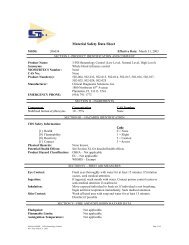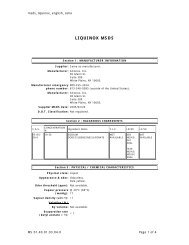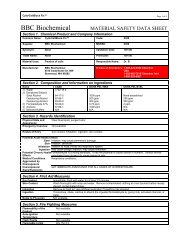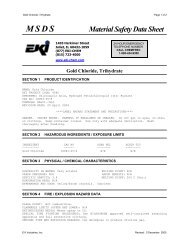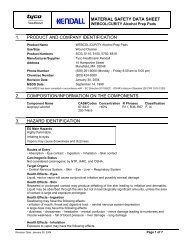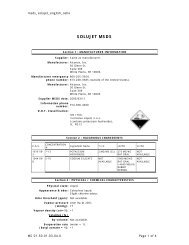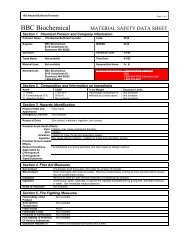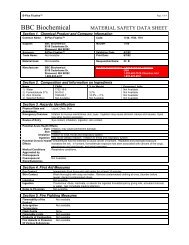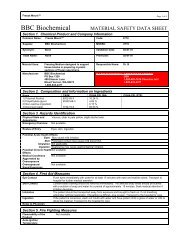BBC Giemsa Stain Regular MSDS - Mercedes Medical
BBC Giemsa Stain Regular MSDS - Mercedes Medical
BBC Giemsa Stain Regular MSDS - Mercedes Medical
You also want an ePaper? Increase the reach of your titles
YUMPU automatically turns print PDFs into web optimized ePapers that Google loves.
<strong>BBC</strong> Biochemical<br />
Section 1. Chemical Product and Company Information<br />
Common Name: <strong>Giemsa</strong> <strong>Stain</strong> <strong>Regular</strong><br />
MATERIAL SAFETY DATA SHEET<br />
Code: 5210<br />
Supplier: <strong>BBC</strong> Biochemical <strong>MSDS</strong>#: 5210<br />
Synonym: None Validation Date: 9/04<br />
Trade Name: None Print Date: 9/04<br />
Material Uses: Histology <strong>Stain</strong>ing Responsible Name: Dr. B<br />
Manufacturer:<br />
<strong>BBC</strong> Biochemical<br />
8510 Cedarhome Dr.<br />
Stanwood, WA 98292<br />
1-800-635-4477<br />
In Case of Emergency: 1-800-424-9300 Chemtrec<br />
USA<br />
1-202-483-7616 Chemtrec Intrl<br />
1-800-225-8867<br />
Section 2. Composition and Information on Ingredients<br />
Name CAS# % by Weight OSHA PEL/ TWA /STEL<br />
1) Methanol<br />
67-56-1<br />
NOTE: Percent composition 200 ppm 250 ppm<br />
2) Glycerin<br />
3) <strong>Giemsa</strong> <strong>Stain</strong><br />
4) Selected Romanowsky<br />
<strong>Stain</strong>s<br />
5) Selected Additives<br />
56-81-5<br />
51811-82-6<br />
N/A<br />
N/A<br />
withheld as a trade secret. 10 mg/m 3<br />
Section 3. Hazards Identification<br />
Physical State and<br />
Appearance<br />
Emergency Overview<br />
Dark blue liquid.<br />
Not available.<br />
Routes of Entry<br />
Eye contact, inhalation, ingestion, skin contact.<br />
Potential Acute Health Effects<br />
Eyes Irritation may cause vision impairment or permanent damage.<br />
Skin Irritation can be toxic by skin absorption.<br />
Inhalation Toxic. Exposure may also cause damage to liver, kidneys and Central Nervous System, especially the<br />
optic nerve.<br />
Ingestion Toxic. May produce blindness, may be fatal.<br />
Potential Chronic Health<br />
Effects<br />
<strong>Medical</strong> Conditions Skin conditions, eye problems, or impaired liver or kidney function.<br />
Aggravated by<br />
Overexposure<br />
Overexposure/<br />
Signs/Symptoms<br />
Section 4. First Aid Measures<br />
Eye Contact<br />
Skin Contact<br />
Inhalation<br />
Ingestion<br />
Notes to Physician<br />
Section 5. Fire Fighting Measures<br />
Immediately flush thoroughly with water for at least 15 minutes.<br />
Wash thoroughly with soap and water.<br />
Remove to fresh air; give artificial respiration if breathing has stopped.<br />
Get immediate medical attention. If medical attention is not immediately available, induce vomiting.<br />
Do not induce vomiting if patient is unconscious.<br />
Not available.<br />
Flammability of the Flammable liquid and vapor.<br />
Product<br />
Auto-ignition<br />
Not available.<br />
Temperature<br />
Flash Points 52°F<br />
Flammable Limits Not available.<br />
Products of Combustion Not available.
Fire Hazards in Presence Not available.<br />
Of Various Substances<br />
Explosion Hazards in Not available.<br />
Presence of Various<br />
Substances<br />
Fire Fighting Media “Alcohol” foam, CO 2, Dry chemical<br />
and Instructions<br />
Protective Clothing (Fire) Wear self -contained breathing apparatus and protective clothing.<br />
Special Remarks on Fire<br />
Hazards<br />
Special Remarks on<br />
Explosion Hazards<br />
Section 6. Accidental Release Measures<br />
Small Spill and Leak<br />
Large Spill and Leak<br />
Section 7, Handling and Storage<br />
Handling<br />
Storage<br />
Evacuate the area of all unnecessary personnel. Wear suitable protective equipment listed under<br />
Section VIII. Eliminate any ignition sources until the area is determined to be free from explosion or<br />
fire hazards. Contain the release and eliminate it’s source, if this can be done without risk. Take up<br />
and containerize for proper disposal as described under Waste Disposal Method. Comply with<br />
Federal, State, and local regulations on reporting releases.<br />
Same as above.<br />
Do not breathe vapor or mist. Do not get in eyes, on skin, or on clothing. Electrically ground all<br />
equipment handling this product. Material must be handled or transferred in an approved fume hood<br />
or with adequate ventilation.<br />
Keep container tightly closed. Store away from heat, sparks, open flame, oxidizers.<br />
Section 8. Exposure Controls / Personal Protection<br />
Engineering Controls Engineering and/or administrative controls should be implemented to reduce exposure.<br />
Personal Protection<br />
Eyes Safety glasses with side shields must be worn at all times.<br />
Body Impervious clothing must be worn to prevent skin contact.<br />
Respiratory If workplace exposure limit(s) of product or any component is exceeded (see TLV/PEL), a<br />
NIOSH/MSHA approved air supplied respirator is advised in absence of proper environmental control.<br />
OSHA regulations also permit other NIOSH/MSHA respirators (negative pressure type) under<br />
specif ied conditions (see your safety supplier).<br />
Hands Butyl rubber, Vitron or equivalent.<br />
Feet Impervious footwear should be worn to prevent skin contact.<br />
Personal Protection in<br />
Case of a Large Spill See above.<br />
Product Name<br />
Exposure Limits<br />
1)<br />
2)<br />
3)<br />
Consult Local authorities before acceptable exposure limits.<br />
Section 9. Physical and Chemical Properties<br />
Physical State and Dark blue liquid. Odor: Alcoholic.<br />
Appearance<br />
Molecular Weight Not applicable. Taste: Not available.<br />
Molecular Formula Not applicable. Color: Dark blue.<br />
pH (1%/Water)<br />
Not applicable.<br />
Boiling/Condensation Not applicable.<br />
Point<br />
Melting/Freezing Point Not applicable.<br />
Critical Temperature Not applicable.<br />
Specific Gravity Not applicable.<br />
Vapor Pressure Not applicable.<br />
Vapor Density<br />
Not applicable.<br />
Volatility<br />
Not applicable.<br />
Odor Threshold Not applicable.<br />
Evaporation Rate Not applicable.<br />
VOC<br />
Not available.<br />
Viscosity<br />
Not available.<br />
Ionicity (in water) Not available.
Dispersion Properties<br />
Solubility<br />
Physical Chemical<br />
Comments<br />
Not available.<br />
Miscible in water.<br />
Not available.<br />
Section 10. Stability and Reactivity<br />
Stability and Reactivity Stable.<br />
Conditions of Instability Not available.<br />
Incompatibility with Acids, oxidizers, reactive metals.<br />
Various Substances<br />
Hazardous Decomposition CO x, Formaldehyde.<br />
Products<br />
Hazardous<br />
Does not occur.<br />
Polymerization<br />
Section 11. Toxicological Information<br />
Toxicity to Animals Methanol 67-56-1<br />
LD50: orl-rat 5628 mg/kg; skn-rbt 15800 mg/kg<br />
LC50: ihl-rat 64000 ppm/4H<br />
LDLo: 143 mg/kg<br />
Chronic Effects on<br />
Humans<br />
Other Toxic Effects on<br />
Humans<br />
Special Remarks on<br />
Toxicity to Animals<br />
Special Remarks on<br />
Chronic Effects on<br />
Humans<br />
Special Remarks on<br />
Other Toxic Effects<br />
on Humans<br />
Tests on laboratory animals indicate methanol may produce adverse mutagenic and reproductive<br />
effects. Cited in Registry of Toxic Effects of Substances (RTECS).<br />
Not available.<br />
Not available.<br />
Section 12. Ecological Information<br />
Ecotoxicity<br />
BODS and COD<br />
Biodegradable/OEDC<br />
Mobility<br />
Not available.<br />
Not available.<br />
Not available.<br />
Not available.<br />
Toxicity of the<br />
Products of<br />
Biodegradation<br />
Special Remarks on<br />
The Products of<br />
Biodegradation<br />
Not available.<br />
Not available.<br />
Section 13. Disposal Considerations<br />
Waste Information Not available.<br />
Waste Stream Not available.<br />
Consult your local or regional authorities.<br />
Section 14. Transport Information<br />
DOT Classification Methanol Solution.<br />
Marine Pollutant<br />
Not available.<br />
Hazardous Substances Methanol 67-56-1<br />
Reportable Quantity Glycerin 56-81-5<br />
Special Provisions for Not applicable.<br />
Transport<br />
TDG Classification Not controlled under TDG (Canada).<br />
ADR/RID Classification Not controlled under ADR (Europe).<br />
IMO/IMDG Classification Not controlled under IMDG.<br />
ICAO/IATA Classification Not controlled under IATA.<br />
Section 15. Other Information
Label requirements<br />
Hazardous Material<br />
Information System<br />
(U.S.A.)<br />
Health 2<br />
Fire Hazard 3<br />
Reactivity 0<br />
Personal Protection<br />
National Fire<br />
Protection<br />
Association<br />
(U.S.A.)<br />
Health<br />
Fire Hazard<br />
3<br />
Reactivity<br />
2 0<br />
Specific Hazard<br />
References<br />
Other Special<br />
Considerations<br />
Validated by Dr. B on 9/04<br />
Notice to Reader<br />
To the best of our knowledge, the information contained herein is accurate. However, neither the above named supplier nor any of its subsidiaries<br />
assumes any liability whatsoever for the accuracy or completeness of the information contained herein.


